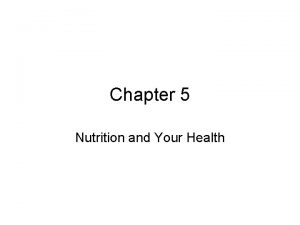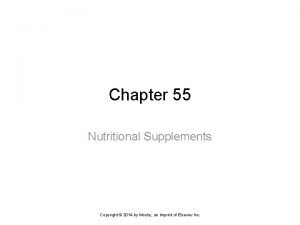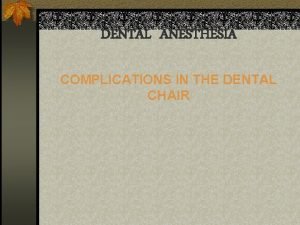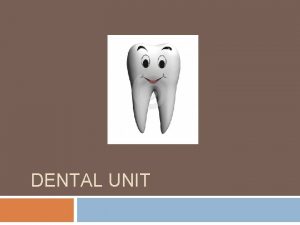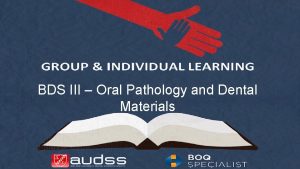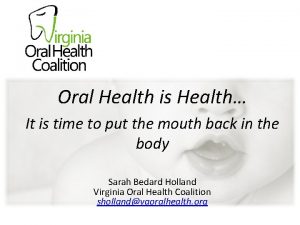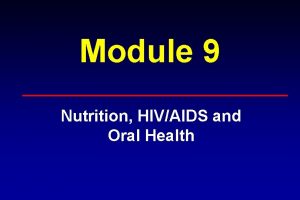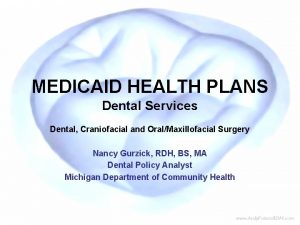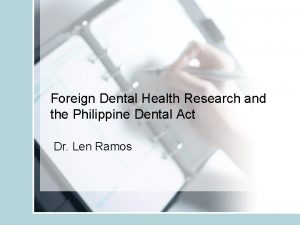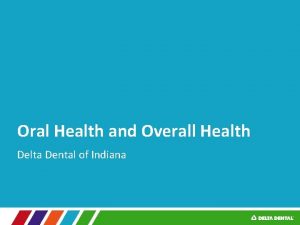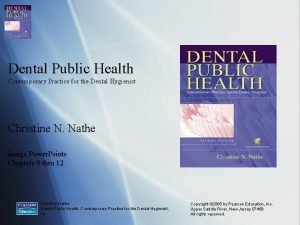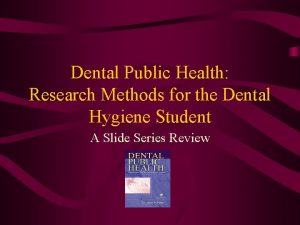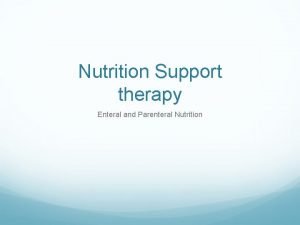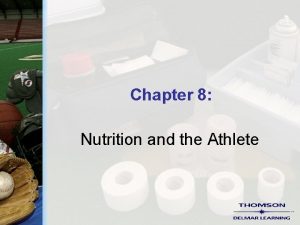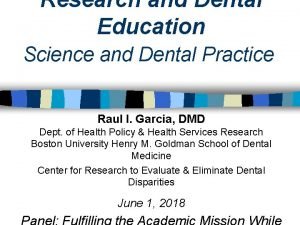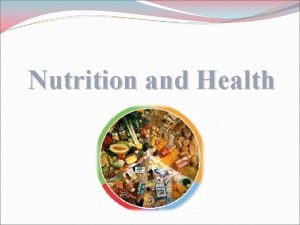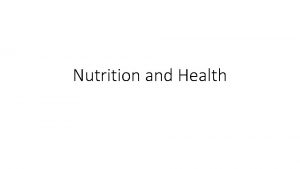Nutrition for Oral and Dental Health Oral Health



























- Slides: 27

Nutrition for Oral and Dental Health

Oral Health • Diet and nutrition play a key role in —Tooth development —Gingival and oral tissue integrity —Bone strength —Prevention and management of diseases of the oral cavity

Effects of Nutrient Deficiencies on Tooth Development

Dental and Oral Health • Teeth are made from protein matrix that is mineralized with collagen (requiring vitamin C), calcium, and phosphorus (requiring vitamins D and A)

Anatomy of a Tooth

Dental Caries • Infectious disease of teeth in which organic acid metabolites lead to gradual demineralization of enamel; proteolytic destruction of tooth structure • Any tooth surface can be affected.

The Decay Process • Plaque formation: sticky mix of microorganisms, protein, polysaccharides • Bacteria metabolizing fermentable carbohydrate produce acid • Acid production: oral p. H<5. 5 allows tooth demineralization • Saliva function: rinses away food; neutralizes acid; promotes remineralization • Caries patterns: pattern depends on cause

Early Childhood Caries • Also called “baby bottle tooth decay” • Nursing bottle caries—putting baby to bed with a bottle of sweetened liquid (juice, Kool-Aid, etc. ) • Front teeth rapidly develop caries • Common among Native Americans • Wean children before age 2 from bottle

Early Childhood Caries (From Swartz MH. Textbook of Physical Diagnosis, History, and Examination, 3 rd ed. Philadelphia: W. B. Saunders, 1998. )

Dental Caries—cont’d • Streptococcus mutans—most common bacteria involved • Fermentable Carbohydrate • Time • Drop in salivary p. H to below 5. 5

Dental Caries—cont’d • Cariogenicity of foods • Frequency of consumption of fermentable Carbohydrate • Food form—slowly dissolving • Food combinations • Nutrient composition of food/beverages • Timing (end of meal)

Fluoride • • • Primary anticaries agent Water fluoridation Fluoridated toothpastes Oral rinses Dentrifices Beverages made with fluoridated water

Recommendations for Fluoride Supplementation (Data from American Dietetic Association: Position of ADA: The impact of fluoride on dental health. J. Am Diet Assoc. 94: 1428, 1994. ) * Milligrams of supplemental fluoride recommended according to fluoride concentration in drinking water.

Cariogenic vs. Cariostatic • Cariogenic: containing fermentable carbohydrates that can cause a decrease in salivary p. H to <5. 5 and demineralization when in contact with microorganisms in the mouth; promoting caries development • Cariostatic: not metabolized by microorganisms in plaque to cause a drop in salivary p. H to <5. 5

Cariogenic Foods • Promote formation of caries • Fermentable carbohydrates, those that can be broken down by salivary amylase • Result in lower mouth p. H • Include crackers, chips, pretzels, cereals, breads, fruits, sugars, sweets, desserts

Cariostatic Foods • Foods that do not contribute to decay • Do not cause a drop in salivary p. H • Includes protein foods, eggs, fish, meat and poultry; most vegetables, fats, sugarless gums

Anticariogenic Foods • Prevent plaque from recognizing an acidogenic food when it is eaten first • May increase salivation or have antimicrobial activity • Includes xylitol (sweetener in sugarless gum) and cheeses

Other Factors that Affect Diet Carogenicity • Consistency: Liquids are cleared quickly while sticky foods remain on the teeth • Meal frequency: frequent meals and snacks increase duration of exposure • Food composition • Food form: liquid, solid, slowly dissolving • Sequence of eating: cheese or milk at the end of the meal decrease the cariogenicity of the meal

Caries Prevention Guidelines

Periodontal Disease • Inflammation of the gingiva with destruction of the tooth attachment apparatus • Gingivitis—early form • Nutritional care involves increasing vitamin C, folate, and zinc

Tooth Loss and Dentures • • • Tooth loss—denture placement Food selections change Saliva production decreases Reduced chewing ability Lower calorie and nutrient intake occurs for many • Simple nutrition counseling; Food Guide Pyramid, etc.

Oral Manifestations of Disease • Stomatitis: inflammation of oral mucosa • Candidiasis and herpes simplex: fungal and viral infections which can affect mouth and esophagus causing pain and dysphagia • Xerostomia: Dry mouth • Periodontal disease • Kaposi’s sarcoma—lesions in mouth and esophagus

MNT for Mouth Pain/ Oral Infections • Avoid acidic and spicy foods • Offer soft, cold, nutrient dense foods such as canned fruit, ice cream, yogurt, cottage cheese • Try oral supplements • Use PEG or NG feeding if oral supplementation is unsuccessful • For xerostomia, try artificial salivas, citrus beverages, sugar free candies or gums

Medications That May Cause Xerostomia

Dental Health Affects Nutrition • Tooth loss may affect ability to chew (relationship between loss of teeth and reduced intake of fruits and vegetables • Dentures are often ill-fitting (especially common after weight loss); problem foods include fresh fruits and vegetables, chewy and crusty breads and chewy meat like steak

Interventions • Obtain a dental consult: if dentures are missing, find them. If they are loose, replace or reline them • Modify diet consistency: mechanical soft, ground, pureed • Use least restrictive diet possible; individualize; mix consistencies if appropriate

MNT for Wired or Broken Jaw • Provide pureed, strained, or blenderized foods as appropriate • Encourage nutrient-dense foods such as blenderized casseroles • Recommend small, frequent meals with oral supplements such as milkshakes, Instant Breakfast, medical nutritionals • Use liquid vitamin supplement if necessary • Recommend patient weigh self to monitor weight status
 Chapter 5 nutrition and your health
Chapter 5 nutrition and your health Project title for health and nutrition
Project title for health and nutrition Chapter 55 nutrition and health
Chapter 55 nutrition and health Iso 22301 utbildning
Iso 22301 utbildning Typiska drag för en novell
Typiska drag för en novell Tack för att ni lyssnade bild
Tack för att ni lyssnade bild Returpilarna
Returpilarna Varför kallas perioden 1918-1939 för mellankrigstiden?
Varför kallas perioden 1918-1939 för mellankrigstiden? En lathund för arbete med kontinuitetshantering
En lathund för arbete med kontinuitetshantering Personalliggare bygg undantag
Personalliggare bygg undantag Personlig tidbok
Personlig tidbok Sura för anatom
Sura för anatom Vad är densitet
Vad är densitet Datorkunskap för nybörjare
Datorkunskap för nybörjare Boverket ka
Boverket ka Debattinlägg mall
Debattinlägg mall Magnetsjukhus
Magnetsjukhus Nyckelkompetenser för livslångt lärande
Nyckelkompetenser för livslångt lärande Påbyggnader för flakfordon
Påbyggnader för flakfordon Vätsketryck formel
Vätsketryck formel Offentlig förvaltning
Offentlig förvaltning Lyckans minut erik lindorm analys
Lyckans minut erik lindorm analys Presentera för publik crossboss
Presentera för publik crossboss Vad är ett minoritetsspråk
Vad är ett minoritetsspråk Vem räknas som jude
Vem räknas som jude Treserva lathund
Treserva lathund Mjälthilus
Mjälthilus Bästa kameran för astrofoto
Bästa kameran för astrofoto
